The Evolution of Machine Translation in the Enterprise
The growing need for an enterprise-tuned & optimized language platform to drive global business momentum and CX
The modern enterprise with global ambitions is experiencing an evolving view of the value, scope, and need for language translation to enhance and build global business momentum.
The old view has been to translate what is mandatory to participate in a global market, but the new view is increasingly about listening, understanding, sharing, communicating, and engaging the global customer. The new view requires a modern global enterprise to translate millions of words a day.
Recent events, the pandemic, in particular, have forced many private and governmental institutions to become much more focused on expanding their digital presence and profile.
It is now widely understood that providing increasing volumes of content to assist, inform, and help a potential buyer understand the products and services of an enterprise, and enhance the customer’s journey after the purchase are important determinants of sustained market success.
The cost of failure to do so is high. In the last 20 years, over half (52%) of Fortune 500 companies have either gone bankrupt, been acquired, or ceased to exist as a result of the digital and business model disruption. Studies suggest many more companies across various industries will disappear because they fail to understand the strategic value of providing relevant content and establishing a robust digital presence to improve CX.
Innosight Research predicts that as much as 75% of today’s S&P 500 will be replaced by 2027.
Rebecca Ray eloquently describes the impact of producing relevant content for the modern enterprise. She describes how Airbnb and Expedia recognize that they are not just lodging companies, but rather high-tech (multilingual) content companies solving lodging problems.
The [most] significant implications revolve around the recognition given to the business value of multilingual content by a high-tech company such as Airbnb through its financial investment in a cross-functional collaboration initiative to greatly expand language accessibility. They must recognize that, in many cases, their products and services do not function independently of information about them and that the most valuable content and code are often generated by third parties.
As more of the world gets more accustomed to a digital-first buyer journey, companies must adapt to stay relevant. As brands face unmatched logistical and communication challenges in the new millennium, they have focused on more engagement with their customers via digital channels.
Customer experience is no longer just a concept. It’s a business imperative that requires cross-functional collaboration, data, and analytics focused on delivering customer success.
The enterprises with the most successful digital transformation initiatives are seeing growth from improved and innovative digital interactions. This usually means cross-organizational collaboration with a digital strategy-focused team leader invested in optimizing digital channels and improving both customer and employee digital experience. Success is often built on data and analytics and the increasing use of AI to generate predictive analytics to power better, more personalized interactions.
The benefits of providing superior CX are increasingly clear:
- #1 – By 2021, customer experience will overtake price and product as the key brand differentiator – Walker
- 86%– of those who received a great customer experience were likely to repurchase from the same company; compared to just 13% of those who received a poor CX – Temkin Group
- 6x– Between 2010-2015, CX leaders grew 6x faster than CX laggards – Forrester
- “Customer Experience leaders grow revenue faster than CX laggards, drive higher brand preference, and can charge more for their products.” – Forrester’s Rick Parish.
- 3x greater return CX leaders outperform CX laggards in terms of stock performance. -- Watermark Consulting
- Consumers will pay a 16% price premium for a great customer experience. - PwC
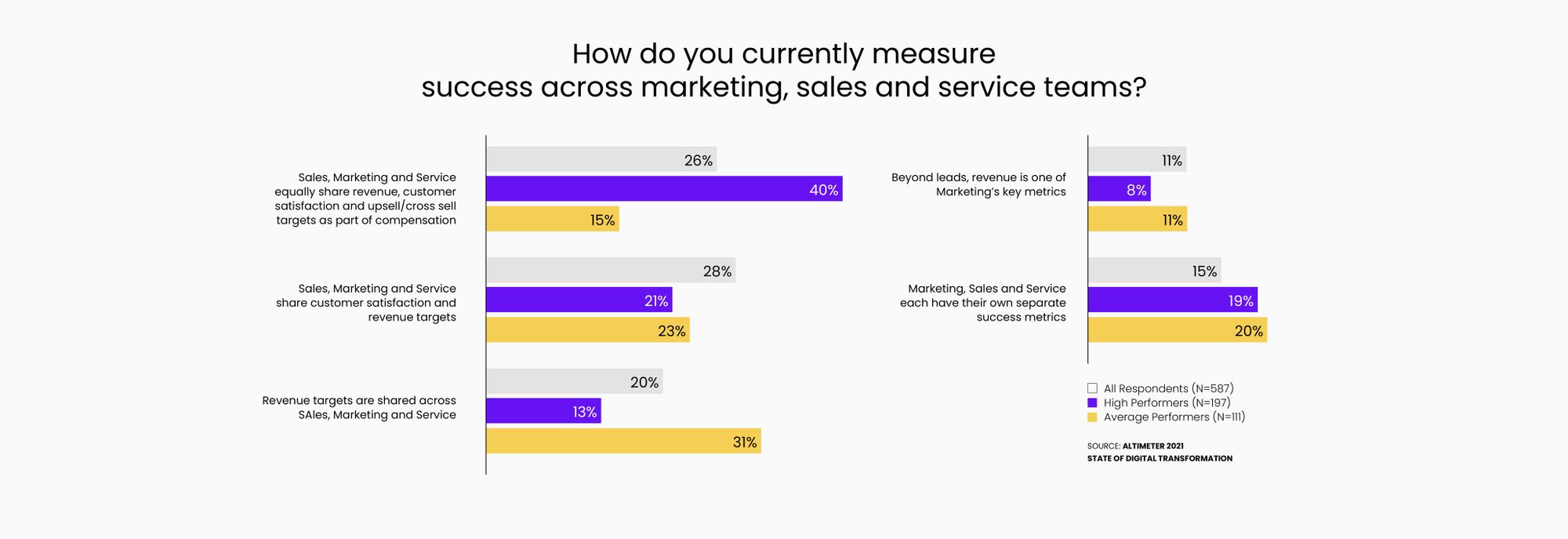
Leaders develop “digital agility”, that enables cross-function collaboration focused on mapping and optimizing customer journeys. The key difference according to Altimeter surveys between top-performing companies and average performers is the ability to use data in prescriptive ways. This means harnessing analytics to make or automate decisions that improve processes like delivering a great customer experience, creating a new product, or defining a new strategy.
There is increasing convergence between marketing, sales, and service goals and operations. This convergence is the natural outcome of the increasing digital sophistication of all customer-facing functions.
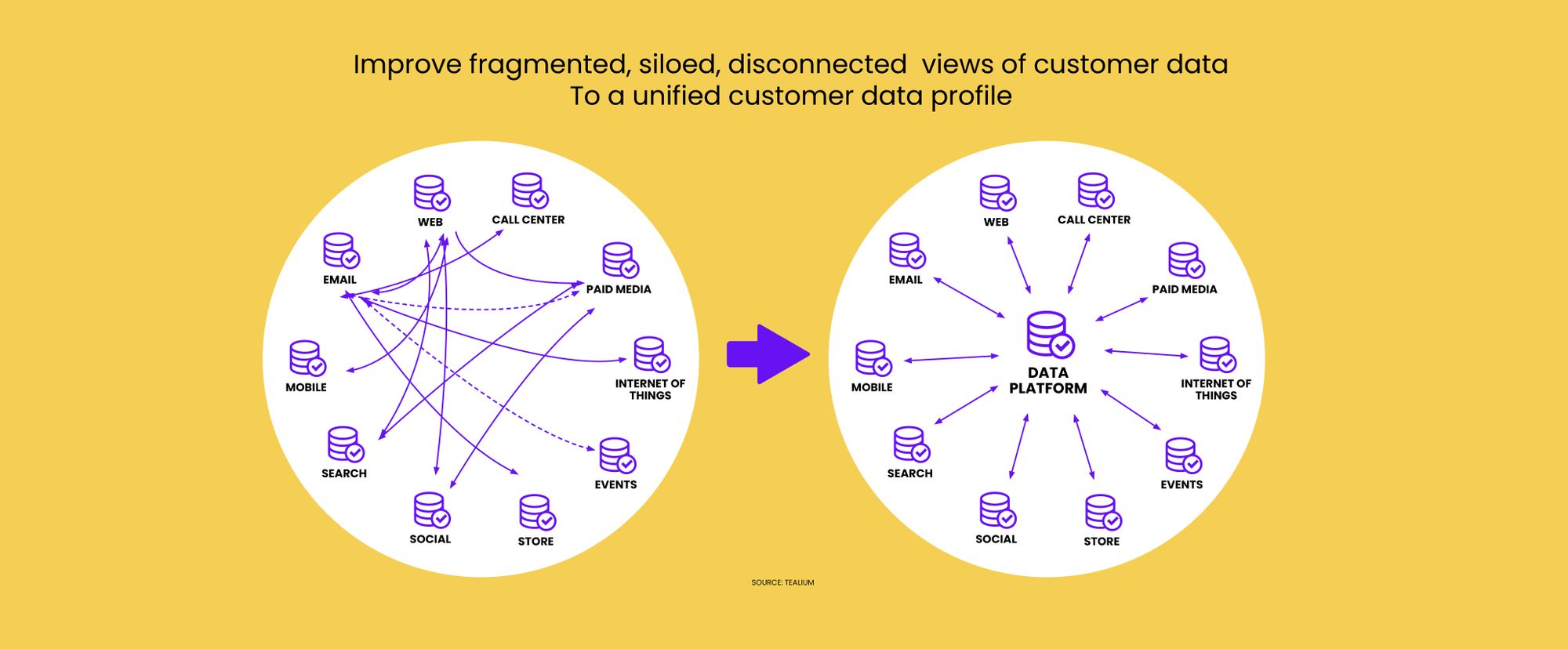
The Localization Implications
There are significant implications from these larger digital transformation imperatives for traditional localization departments. The needs and scope of language translation for the modern digitally-agile enterprise are significantly greater than ever seen historically.
This is resulting in a changing view of the localization function within the enterprise. Ranging from being seen as a vital partner in global growth strategies to sometimes being relegated to low-value contributors for those less engaged localization groups whose only focus is measuring translation quality (badly) and juggling LSP vendors. These latter groups will see customer-facing departments take over large-scale CX-focused translation initiatives and slip into further obscurity.
Airbnb is an example where the localization team is seen as a vital partner in enabling global growth. The Airbnb localization team oversees both typical localization content and user-generated content (UGC), across the organization, which means they oversee billions of words a month being translated across 60+ languages using a combined human plus continuously improving MT translation model. The localization team enables Airbnb to translate customer-related content across the organization at scale. High-value external content is often accorded the same attention as internally produced marketing content.
Digital agility requires that a modern era localization team be the hub of cross-functional collaboration to facilitate and enable all kinds of content to be translated to expedite understanding, communication, and experience of customer-related issues. The modern enterprise will likely need millions of words translated every month to understand, enhance, and improve the global customer experience (GCX). In the B2C scenario, the volumes could even be billions of words per month.
Continuously improving responsive MT is a critical foundation to building better GCX. Increasingly we will see more and more content come directly from carefully optimized MT to the customer without additional human intervention. The linguistic human oversight process and approach will likely change. Upfront human feedback investments will be needed in addition to selective post-editing to make these enterprise MT engines perform optimally on a range of unique and specialized enterprise content. It is possible to post-edit 100K words a month, but it is not possible to do this for a million or a billion words a month.
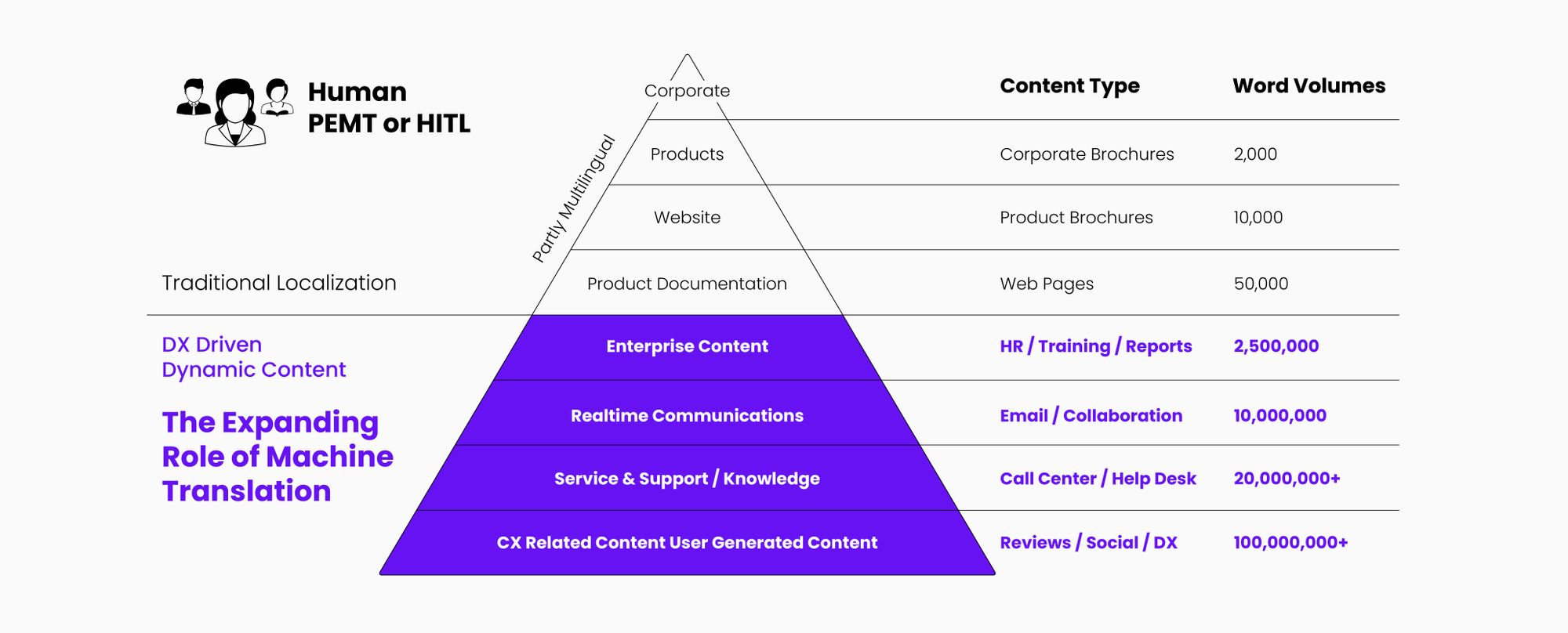
We are seeing an emerging translation model (e.g. at Airbnb) that enables an enterprise to build virtuous cycles of continuously improving machine translation working closely together with regular ongoing human feedback.
All focused on cross-functional alignment with the larger enterprise goal of reducing customer friction and increasing customer delight.
Superior CX is built on active, ongoing conversations with the customer to ensure the best possible experience and outcomes. It involves active and continuous listening to the voice of the customer on social platforms to identify problems and success early. It involves multiple levels of communication. Large volumes of multilingual data flows have created a huge and growing need for rapid translation.
Thus, the emerging CX-focused and digitally agile modern enterprise is likely to be one that regularly does the following:
- Helps to provide a uniform customer data profile across the world to achieve a common understanding of the customer.
- Translates over 100 million or even billions of words a month to support GCX in various ways. This means that 95%+ has to be done by optimized adaptive MT engines.
- Has informed human feedback driving continuously learning MT systems. This feedback may only amount to 1% or less of the raw MT that is freely flowing to support understanding, communication, and research of customers across the globe.
- Helps provide a common view on the increasing convergence between marketing, sales, and service content and operations without any language barriers. This has great value for the internal understanding of international customer needs and again enables speedier, better-coordinated responses to differing international customer needs.
- Improves global understanding and communication within and without the enterprise.
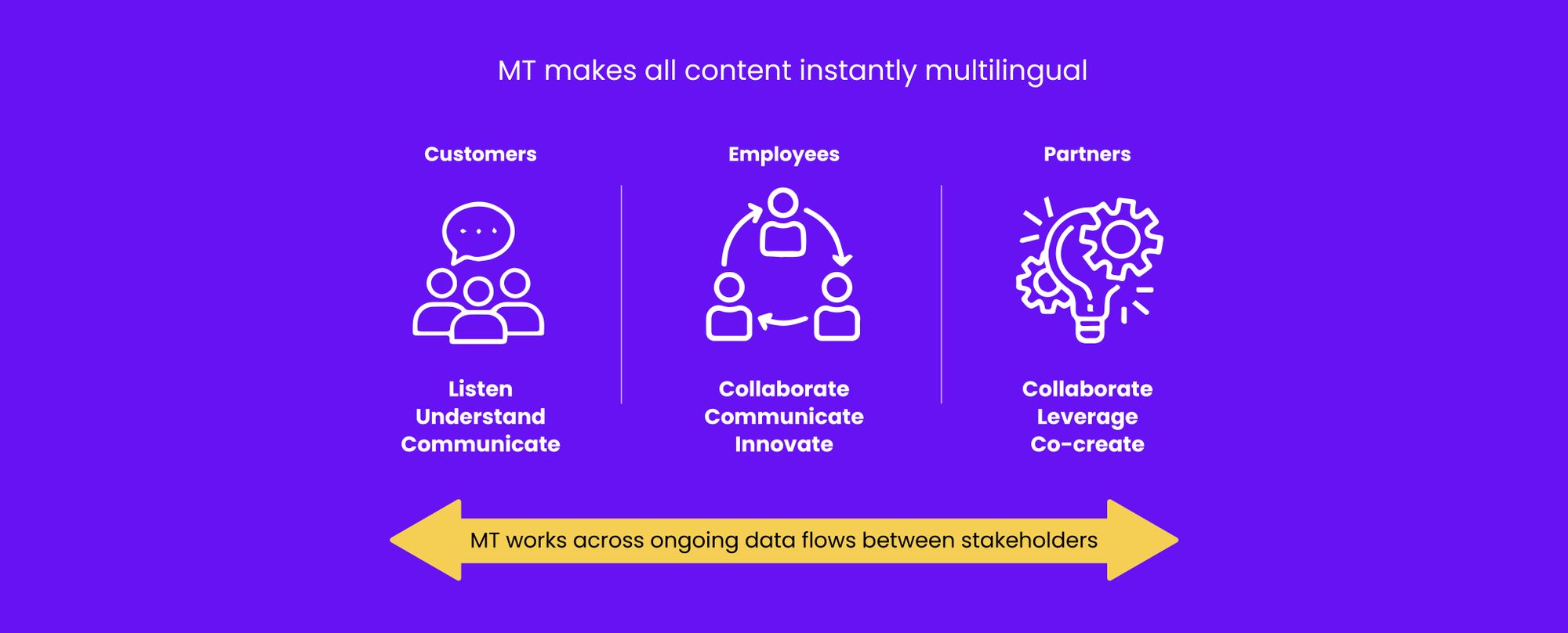
The State of Machine Translation in the Enterprise
Machine translation output quality has improved dramatically over the past decade, but all stakeholders should understand that MT is not a perfect replacement for competent human translation. Yet, if properly used and optimized, it can rapidly enhance the transparency of all multilingual data flows in the modern enterprise and expedite international business initiatives.
The use of MT in the enterprise is clearly on the rise. The overall content deluge, the need to monitor brand feedback on social media, and a much more rapid digitally-driven global presence are some of the factors that drive this use.
Global customer service and support and eCommerce have been the most active use cases historically. But increasingly we see that that the global enterprise recognizes the need for a personalized and optimized MT-based translation utility that is secure, private, and enterprise content-tuned to make all multilingual information easier to share, access, and understand.
Recent Changes Driving Faster MT Adoption
- Human evaluations show that neural MT is often indiscernible from human translation for much of the high-value customer service content that is needed for CX improvement.
- Direct customer feedback on the usefulness of MT content suggests that many customers are willing to accept “imperfect” MT if it means that they get broader content access and faster response during many stages of the customer journey.
- The pandemic has made the need for an expanded digital presence much more urgent. MT enables the acceleration of a global “digital-first” strategy.
- The increasing awareness at executive levels of the need for global inclusion and recognition that the fastest-growing markets in the world today are in Africa and SE Asia.
- The increasing awareness in the enterprise of the need and impact of greater availability.
- The increasing importance of community content is increasingly recognized business-enhancing customer creator content.
- An understanding that the next billion potential customers coming to the internet are unlikely to speak English, FIGS, or CJK.
One important point of understanding within a global enterprise is to recognize that different kinds of content need different translation processes. MT is very useful in making high volume, rapidly flowing, short shelf-life content multilingual, but is less suited to high impact executive communications or high liability impact types of content where nuance and semantic accuracy are central.
The mix of human-machine contributions tends to be closely linked to the volume and nuance contained in the source data. The following chart roughly shows the relationship between the content type and the translation approach used. The translation production mode has to be tuned to the needs of target consumers of information and could range from assimilation, dissemination to publishable quality requirements. For example, internal cross-lingual emails can stand a lower average quality translation than customer support content even though both can be voluminous.
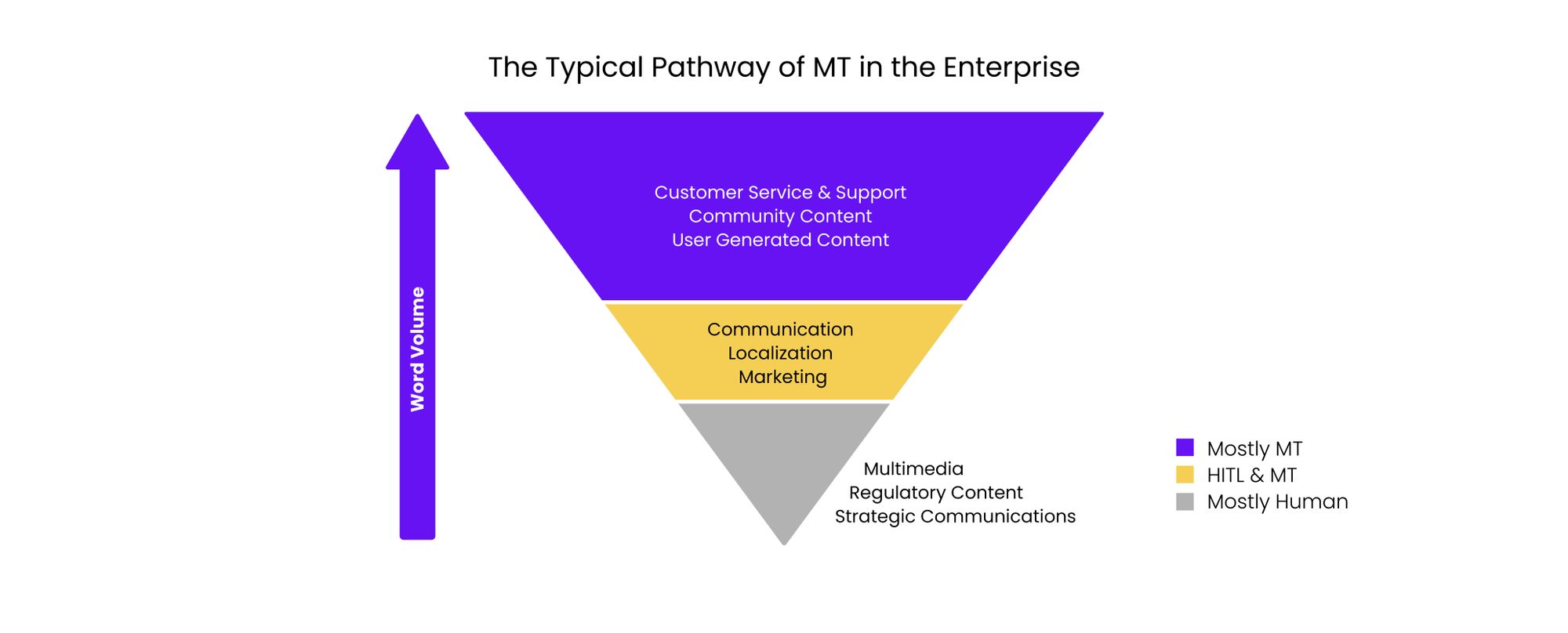
What Does an Enterprise Need from an MT Solution?
In considering MT technology options there are several attributes that an enterprise needs to understand in an evaluation. While there is often an over-emphasis and focus on generic, mostly irrelevant MT score-based comparisons, in reality, other factors often matter much more in producing higher ROI and successful outcomes. For example:
Data Security & Privacy: As more CX and confidential product information starts flowing through MT, data security and privacy is our primary concern. CX data may often be considered even more valuable than product information. Many generic public portals present challenges in ensuring the assurance of data privacy. Flexible caching options for different content types are an increasingly important concern.
Rapid Adaptability to Enterprise Content and Use Cases: Enterprise use of MT makes the most sense when the MT performs well on unique enterprise content and terminology. The ability to do this quickly and accurately with minimal startup effort is perhaps the single most valuable aspect of MT technology to an enterprise. There are likely to be many use cases and MT systems like ModernMT, that can leverage existing linguistic assets across multiple use cases with minimal overhead, and system redundancy is much easier to manage and update than a lot of traditional MT systems. Continuous improvement capabilities allow MT systems to evolve and improve over time and thus responsive, highly adaptive MT systems like ModernMT that improve daily are much more likely to produce successful outcomes.
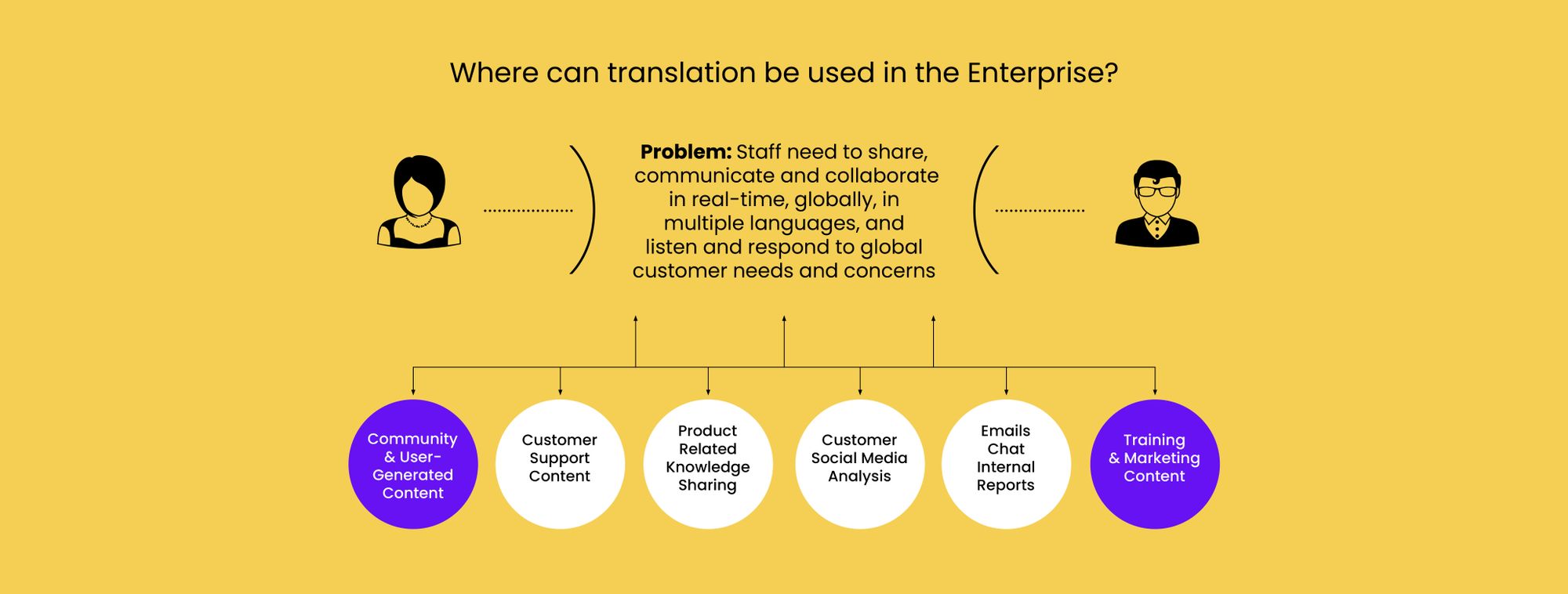
Superior MT Output Quality: While generic MT comparisons by third parties can be useful to understand the potential experience with an MT solution, it is much more important to understand how an MT solution performs on your specific enterprise content. Perhaps even more important is how rapidly and easily an MT system can improve and learn your specific enterprise terminology and linguistic style.
Ease of Integrating Human Corrective Feedback: While some MT systems can produce excellent output occasionally, none can do this all the time.
Human corrective feedback is key to improving MT system performance on an ongoing basis. The ease, speed, and impact with which human feedback is incorporated into driving ongoing MT system performance improvements is a valuable characteristic for an MT system.
ModernMT has been architected to learn rapidly from human corrective feedback and learns continuously and rapidly. The low overhead of adapted models also makes it possible to have hundreds of different models that are easily updated and maintained as improvements can flow from model to model if they have similar content.
Expert Consulting Services: As MT-based translation services become more commonplace in the global enterprise, the reach of rapid translation capabilities will expand and extend through an organization.
It may be necessary to connect different content-containing systems to the MT engine or special linguistic analysis may be needed to speed up the development of systems optimized for new use cases.
MT providers who have this expertise to build a Translation Operating System that can handle a variety of different kinds of data and service types with high efficiency will make the deployment easier, and also increase the probability of success.
ModernMT is a context-aware, incremental, and responsive general-purpose MT technology that is price competitive to the big MT portals (Google, Microsoft, Amazon) and is uniquely optimized for LSPs and global enterprises, and addresses all the criteria specified above.
ModernMT can be kept completely secure and private for those willing to make the hardware investments for an on-premise installation. It is also possible to develop a secure and private cloud instance for those who wish to avoid making hardware investments.
ModernMT overcomes technology barriers that hinder the wider adoption of currently available MT software by enterprise users and language service providers:
- ModernMT is a ready-to-run application that does not require any initial training phase. It incorporates user-supplied resources immediately without needing laborious, technically overly complex, and tedious upfront model training.
- ModernMT learns continuously and instantly from user feedback and corrections made to MT output as production work is being done. It produces output that improves by the day and even the hour in active-use scenarios.
- ModernMT manages context automatically and does not require building multiple different domain-specific and use-case-specific systems.
- ModernMT has a data collection infrastructure that accelerates the process of filling the data gap between baseline systems and enterprise-specific models with unique terminology and linguistic style.
- ModernMT is responsive to small volumes of corrective feedback and thus allows straightforward deployment in multiple organizational scenarios.
- ModernMT’s goal is to deliver the quality of multiple custom engines by adapting to the provided context on the fly. This fluidity makes it much easier to manage on an ongoing basis.
- ModernMT provides extensive control over the MT cache allowing immediate no-trace deletion to a permanent (annual) cache for highly static public content.
- ModernMT can scale from millions to billions of words a day with responsive and modifiable performance through the range.
- ModernMT systems can easily outperform competitive systems once adaptation begins, and active corrective feedback immediately generates quality-improving momentum.
Thus as we head into the post-pandemic era, the need for a broadly capable, private, secure, corporate-domain tuned "translation engine" will only grow in importance for the digitally agile, CX-savvy global enterprise.
Localization teams will need to lead multi-year investment initiatives that are recognized by executives as essential drivers for their organizations’ global growth and revenue to enable this.
The shift to language as a feature at the platform level wherein language is designed, delivered, and optimized as a feature of a product and/or service from the beginning is now underway.
As Airbnb CEO, Brian Chesky stated in his launch video, “Technology made it possible to work from home, but Airbnb now allows you to work from any home.” Obviously, language independence is an integral part of his platform that now makes this possible. His success will demand that others follow.
ModernMT is a product by Translated.

